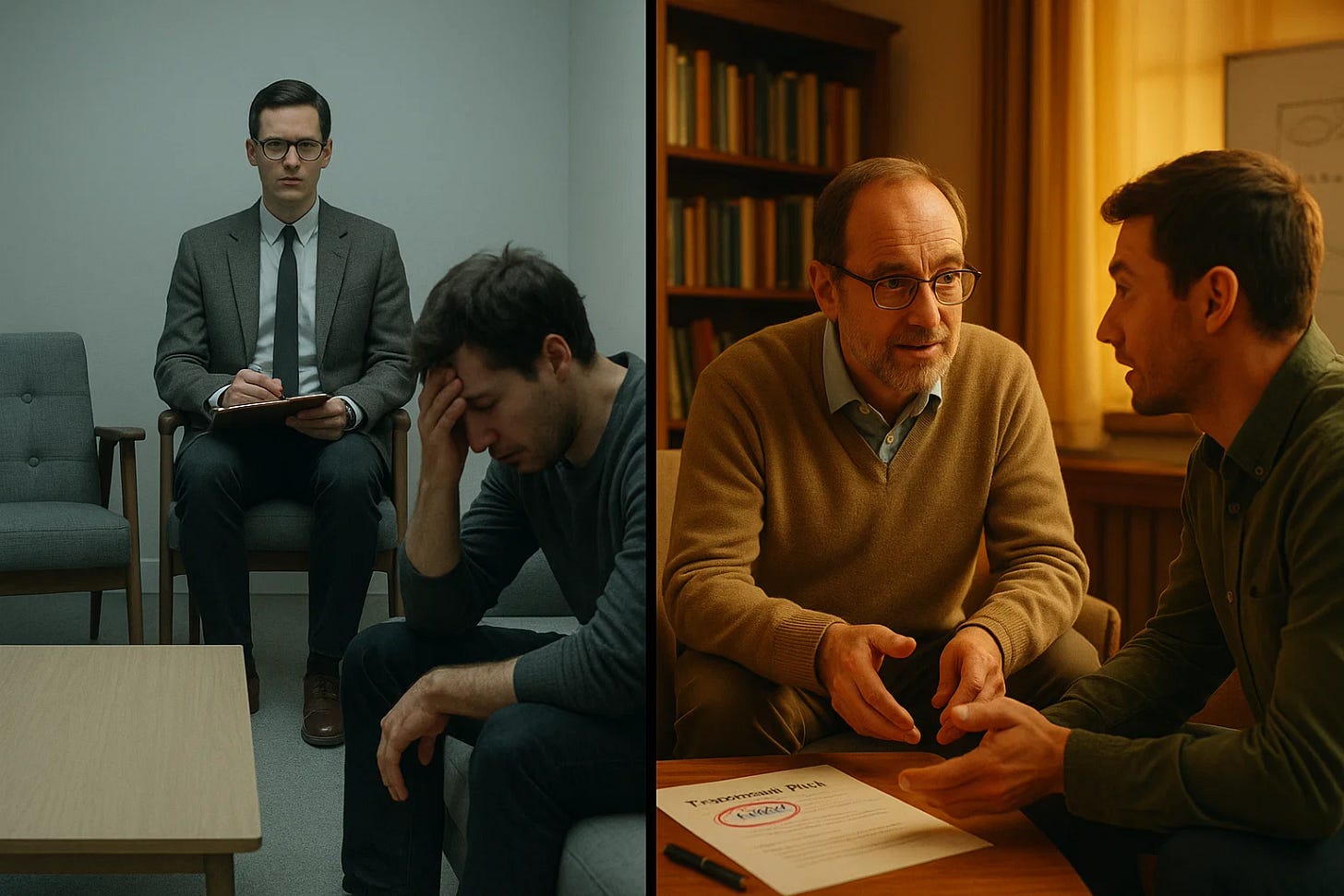The Peril of Passive Therapy
When "Holding Space" Becomes Holding Back: Why True Progress Demands More
I’ve spent a large part of my adult life in therapy.
Sometimes it’s helped. Sometimes it hasn’t.
And over the years, I’ve learned to tell the difference between presence and progress, between holding space and actually moving through it.
The therapists who helped me the most didn’t just listen; they also provided guidance. They engaged. They interrupted. They challenged. They risked discomfort to create change.
But I’ve also experienced another kind of therapy, one that’s far more common than we like to admit. The kind where the therapist is physically present, emotionally warm, and professionally careful… but ultimately passive.
They mirror, reflect, nod. They validate my feelings. But when the pain deepens or the confusion sharpens, they go quiet, unable or unwilling to offer anything more than continued attendance. And in those moments, what was meant to be support feels more like abandonment in slow motion.
It’s not malicious. It’s not even negligent, at least not in the legal sense.
But it is a kind of therapeutic inertia— a fear of leading masquerading as respect for the process.
I’ve come to recognize this not just in my own experience, but in the way mental health care often operates more broadly, especially around children. Too often, we assume that presence is enough. That showing up, week after week, in a safe room with kind eyes and a neutral tone, will somehow spark transformation.
But presence without direction isn’t always helpful.
Sometimes, it’s just another way of avoiding responsibility.
When therapy avoids conflict, hard truths, or systemic patterns, and instead relies on observation rather than action, it risks reinforcing the very dynamics that bring people to therapy in the first place.
That’s something I’ve lived. And it's something I've observed in other settings as well, where passivity was mistaken for patience, and the absence of progress was rebranded as “trusting the process.”
We all deserve better than that.
Therapy isn’t supposed to be just a mirror.
It’s supposed to be a map.
And Then... There’s Richard
Richard is my therapist. And working with him has made it impossible for me to tolerate the theatrical empathy so common elsewhere.
Because here’s what Richard didn't do:
He didn’t wait six sessions to challenge my distortions.
He didn’t confuse my suffering with my story.
He didn’t “hold space” while I fell apart—he intervened.
He didn’t pretend neutrality when the stakes were high; he got in the boat with me and started rowing.
Richard taught me that therapy isn’t sacred. It’s a tool. And tools are useless if no one uses them.
Because of Richard, I’ve:
Confronted what I most wanted to avoid.
Broken patterns I thought were permanent.
Felt challenged, not coddled.
Developed discernment, not dependence.
He didn’t give me space. He gave me structure. He didn’t just reflect me. He redirected me.
Richard practiced what the rest of the field often preaches but rarely delivers:
Ethical confrontation. Directed care. Relational honesty.
The Rehearsal: Or, What Most Therapy Has Become
To understand what’s wrong with most modern therapy, watch The Rehearsal. Meticulous planning. Scripted compassion. Simulated safety. Emotional detachment masked as brilliance.
That’s how too many therapists are working now.
“We’re just exploring.”
“You’re the expert on your experience.”
“This is your space.”
No.
You’re performing a therapeutic version of reality TV, where risk is airbrushed out, and what passes for growth is just a high-production stall.
Let’s Call This What It Is
Conflict avoidance in the clinician
Rigid over-accommodation to client fear
Mirroring as a shield against accountability
Process addiction in place of progress
These are not neutral behaviors.
They are clinical enactments of the very dysfunctions therapy is supposed to treat.
If your therapist can’t tolerate escalation, confrontation, or emotional directness—
They’re not holding space.
They’re holding back.
A Treatment Plan for the Mental Health Profession
Presenting issues:
Emotional disengagement by clinicians
Institutional overprotection of inaction
Ritualized empathy masking clinical underfunctioning
Treatment goals:
Restore real-time responsiveness to visible distress
Interrupt patterns of therapeutic codependency
Train clinicians in discomfort tolerance and relational repair
Normalize therapist-initiated movement, not just reflection
Required modality:
Let’s try... Richard.
Therapy Isn’t Magic. It’s a Method.
And It Has to Work.
Richard proved that therapy can confront, redirect, and disrupt.
He showed me that healing requires more than being seen; it requires being challenged, supported, and led.
If the mental health field wants to maintain its credibility, it needs to stop merely discussing care and start delivering it.
Because the worst kind of harm isn’t loud.
It’s quiet.
It’s what happens when you cry for help and someone takes notes.




